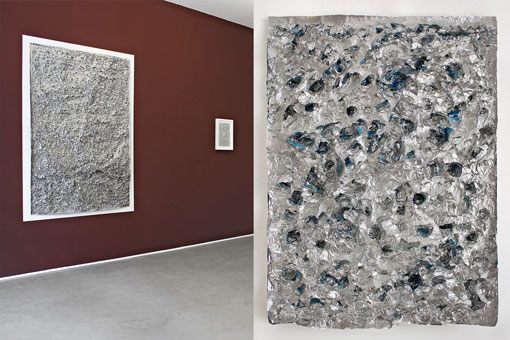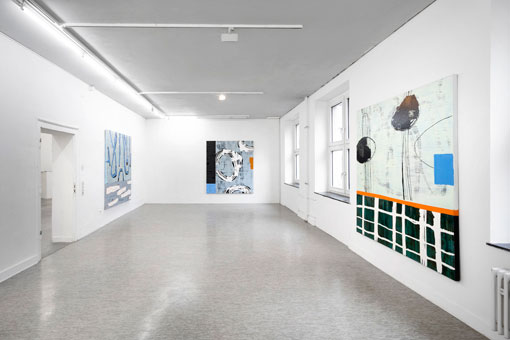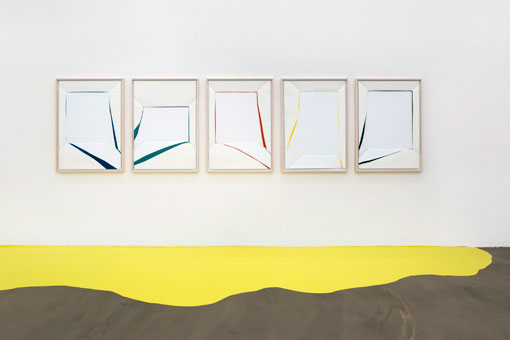
"Farbe.Licht.Raum": an inseparable trinity. An inseparable trinity, that is, if we reduce all five senses to the single sense of sight. The exhibition, "Farbe.Licht.Raum" contains paintings, not only in the form of the traditional panel painting that we might expect. Here, and in direct contradiction to the title, we are presented with austere black and white, or situations in which the colour is applied to carrier materials other than canvas. At first, we might still believe we are encountering a flat panel painting, but on closer inspection we are confronted with an entirely different materiality, in which colour and carrier material develop with each other.
Even as an installation, we still experience painting in the exhibition, but it is floating in space, on a paper-carrier, or as a high-gloss, architectural intervention. Light, which grants us access to sensory viewing experiences, is an important part of site-related works. In these works, light itself becomes colour. In "Farbe.Licht.Raum", painting, sculpture and installations are combined, thereby opening up visual as well as conceptual spaces in and around the artworks.



For Sybille Hassinger, colour and light are among the most important considerations when she’s searching for images to base her paintings on. Hassinger’s works display a subtle interplay between opacity and lucidity, and utilise pictorial signs that emerge through colour and shape, colour and line, shape and anti-shape. Dialogues between pastel tones and assertive colour-fields, line-structures reminiscent of chirographic script, fragile grid-fields, and circular shapes with cell-like connecting lines form the essential artistic formal vocabulary of her painting practice. Some of her works, which oscillate between transparency, delicately coloured glaze layers, and condensed, opaque colour surfaces, generate a kind of floating sensation.
Her works fascinate through a masterly perspectival interplay between pictorial foreground and background, through the continual dialogue between colour and form. The artist herself describes the suggestive spatial impact of her large-format works thus: “The pictures appear to be inwardly breathing…it is like one is physically immersed into the picture.” (Marina Schuster, Museum Kunstpalast, Düsseldorf)

The series of “uneconomic drawings” – drawings on aluminium foil – are not only autonomous objects, but a bridge between painting and sculpture. In their own way, the lyrically charged sheets succeed in both preserving and utilising their fragile materiality.
The pitted structures and drawings, which adopt a form reminiscent of a relief, represent an enquiry into presence/absence, reflection and visualisation of the conceived space. By seeing his own image reflected back at him, the visitor becomes a part of the works’ pictorial space.

The Dutch artist Arjan Janssen makes paintings and drawings, masterfully oscillating between each discipline. His visual language in both mediums brings together a strict image composition and a spare, restricted range of colours. He draws with dark Siberian chalk, which he guides along a ruler using hard strokes, forming structured surfaces and grids. He combines these with his working traces to produce the final image.
In his large-format oil paintings, gesture plays a less distinct role. The paintings chosen for the exhibition are constructed by dividing the image into distinct white, grey and black surfaces, which generate a corporeal confrontation with the viewer. The adroit, subtle colour nuances appear to respond to the changing position of the viewer, and the resulting change of light. As the observer moves, the fine textures of the colour fields, the directions of the strokes, and individual colours’ attributes reveal themselves, and it is only during this process that Janssen’s feedback loop between painting and drawing announces itself.

For nearly twenty years, Paul Schwer has been working in the expanded sphere of the supreme field of art that has been pronounced dead over and over again: painting. (…)
In his painting-related concepts, Schwer deals with moments of retinal perception, and with the transformation of such moments into pictorial constellations in which the elusiveness of this perception manifests itself.
One could also say: Paul Schwer’s approach to painting wants to record that ultimately nothing can be recorded. That everything flows past, everything is subjected to an instantaneous elusiveness and fragility. (…) Schwer’s materials are usually found in a technical, industrial context (racks, fluorescent lamps, Perspex, polystyrene-hard foam), but are repurposed in his hands in order to generate a poetic buoyancy and softness, fluctuating between constructive stasis and rapid dynamics. Only rarely does actual painting play the main part, but everything in his universe is – to varying degrees – arranged in a painterly way. What we see in Schwer’s work is, in a way, the creation of painting out of the non-painting. (From: Ruppige Schönheit by Stephan Berg)

Elisabeth Sonneck addresses the tension or gravity inherent to the material and the intrinsic behavior of the paper when staging her lengths of paper painted in oils on one side, spirally entangling them, piling them like columns, dangling them as loops from the wall, or balancing them like mobiles. (…) for Sonneck, the work of art is not a structure that is something crystalline, having been brought to a standstill, but one characterized by process – the material dictates the form. (...)
This manner of working inherent to the process of creating the art and the dynamically-motivated appropriation of the material, the unique use of colors, and the linear, evenly repetitive action in contrast with the repeated reshaping into delicately balanced, variable objects express a rhythmic strength that corresponds with a statement by Henri Maldiney: “Rhythm weaves through space (and time) with an existential significance, that is to say, with a meaningful present.” He emphasizes the existence of the now as a latently extant category of space and time, the irrevocable presence of the individual moment, in which duration and the moment are identical (…)
[Ursula Ströbele; transl. by Elizabeth Volk]
www.elisabeth-sonneck.de

English coming soon!
Die Invasion des Raumes durch Farbe ist seit vielen Jahren Kennzeichen des Werkes von Rainer Splitt. Der in Berlin lebende Künstler ist vor allem durch seine raumgreifenden Farbgüsse bekannt: spiegelnde Farblachen auf dem Boden, entstanden durch die einfache Handlung des Ausgießens, die Charakteristik des Fußbodens und die Konsistenz der Farbe. Die Farbe malt sich selbst und zeigt, je nach Betrachterstandpunkt, ihr Kolorit oder die eingespiegelte Umgebung.
Wo ist das Bild? Wo fängt es an, wo endet es? Wird der Betrachter vom Subjekt zum Objekt, wenn Bild und Raum identisch werden?
Für Dortmund hat Rainer Splitt einen schwefelgelben Farbton gewählt- der Raumkante des Ausstellungssaals folgend fließt sie bis in den Vorraum und breitet sie sich in unserem Foyer aus. Das Konzept von Malerei als Handlung mit Farbe zeigt sich ebenso in zwei korrespondierenden Paperpools: Zu Schachteln gefaltete Papiere werden mit Farbe gefüllt, entleert und anschließend zurück in die Fläche gefaltet. Farbe präsentiert als überraschend präzise Zeichnung des abwesenden Volumens.
www.rainersplitt.de

Claudia Vogel works on multiple images simultaneously, and then extracts a random selection to show in her exhibitions. In one series of works, she covers wooden frames with finely woven textiles or nets, which then provide a grid-like structure for the picture’s background. Vogel then pushes colour through the finely woven fabrics from the reverse side, which creates the image structure on the front. In these works, she uses oil paint or liquid synthetic resin, which begin to set during the time-intensive creative process. The exhibition title, “Random Samples,” refers in its literal sense to the creation and selection of these works, but the term “random sample” also describes a sample taken from a fluid material flowing onto a surface.
The form each work in the series takes is therefore characterized by the combination of each individual physical element. When the various viscosities of paints and resins meet the various densities and compositions of each carrier material, a heavily structured picture surface emerges. (Sandra Kraemer M.A.)
www.institut-aktuelle-kunst.de/kuenstlerlexikon/vogel-claudia

For the exhibition "Farbe.Licht.Raum" Ulrich Vogl has developed a site-specific installation which plays with the particular architectonic conditions in the old colliery building. In the installation, Rear Window, an apparently unnecessary window to a sub-cellar creates, through a curious shadowplay, an image on the seven metre high shaft wall opposite. This work is not unlike Vogl’s earlier installation, Window, which he has shown numerous times since 2010. In both installations, Vogl used plants and fans as basic materials whose properties are contingent to both the architecture and the season of year, thereby producing highly changeable forms and shadows depending on the conditions they find themselves in. Similarly, Rear Window is in constant motion, emanating – in its simplicity – a contemplative quietness. In many of Vogl’s works, light and shadow play a prominent role, while black and white are the dominant “colours”. The expansion of drawing can therefore be seen as a driving force within his practice, an expansion that is further increased in his installation in Dortmund.
www.ulrich-vogl.de







